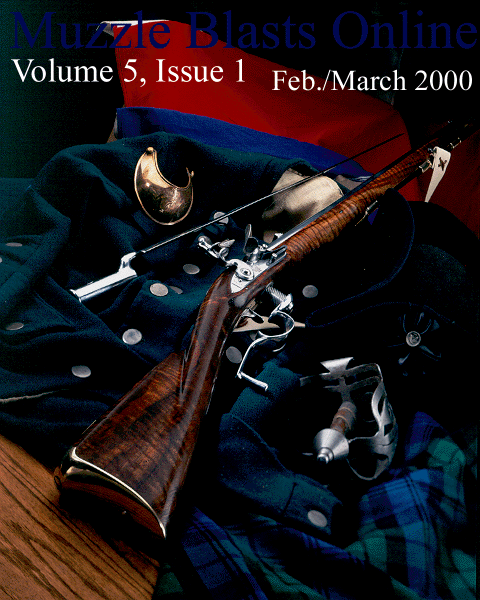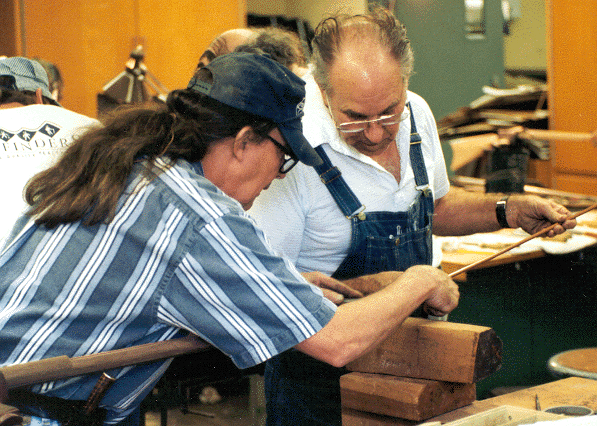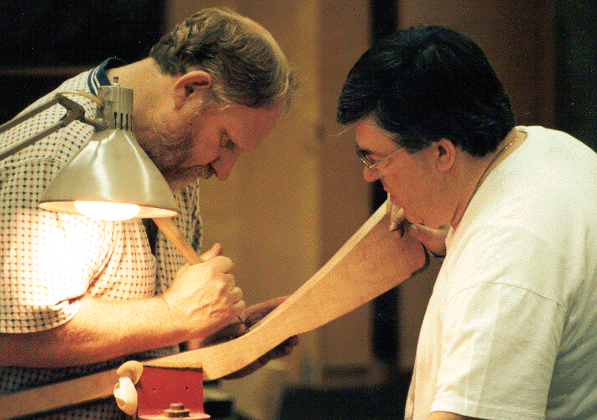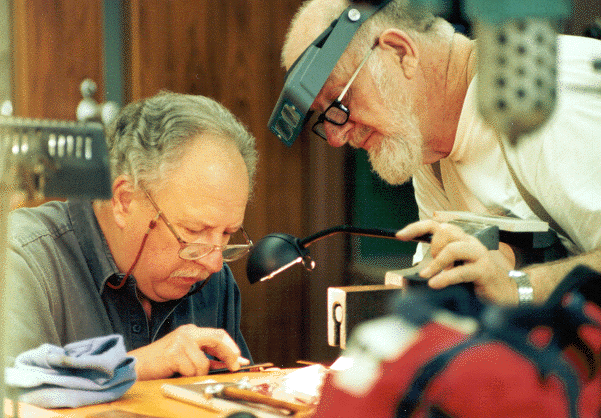|
Muzzle Blasts Online |
|
...for the muzzleloading enthusiast |
|
The muzzleblasts.com domain, subdomains, content, etc., are neither affiliated with the NMLRA nor its paper magazine Muzzle Blasts |
|
Muzzle Blasts Online |

|
|
|
|
|
|
Borrowing Fire
The 1999 NMLRA Gunmaking Seminar

|
|
Wallace Gusler presented an intensive class on design and drawing for the American longrifle. |
Western Kentucky University was once again host to the NMLRA Gunmaking Seminar and Workshop, where over fifty students of the American longrifle convened to study specific aspects of their craft from some of the trade's greatest living practitioners. From forging and welding yellow-hot steel to producing delicate scrolls with a graver under high magnification, the classes focused on most of the important tasks involved with the correct and artistic production of the American longrifle. Not merely a series of demonstrations, this is an intense, some might say exhausting, hands-on tutorial where students repeatedly practice their skills with an instructor who's never far away.
The format of the classes was similar to those of past years, and was roughly divided around either a particular style of rifle that could be stocked in its entirety, or a particular skill within the stocking process. Students could come in for a single three-day class, or they could stay and build on their skills in a full-length course, whatever their personal schedules allowed.
This year, the successful short courses were taught again, and represented a full weekend of work on a particular aspect of this craft.
Mark Silver taught a class on the burnishing, scraping, and polishing of wood and metals, sharing his insights on these historical processes for producing a smooth finish without resorting to modern techniques. A great many 18th-century craft practices are entirely practical and highly efficient, and apart from creating a look that cannot be obtained with modern techniques, they can play a large and cost-effective part in a modern working shop.
Wallace Gusler and Gary Brumfield presented an intensive class on drawing techniques as specifically related to designing rococo carving and engraving for patchboxes and cheekpieces. Dozens of color slides of beautiful rifles (many of them never seen before except by a few collectors) were copied in minute detail so that students could begin to understand how sophisticated and subtle much of this ornamentation really is, and could take home a catalog of designs for their own use.

|
|
Hershel House (left) taught an in-depth course on stocking an iron mounted southern rifle. |
One of the more demanding skills of stocking a rifle is correctly inletting the swamped barrel, and Jack Brooks taught his class members just this skill, as he does it in his own shop. Not using the metal rails that many builders use as guides, Jack's techniques produce a tight-fitting inlet and remove much of the worry that many have about this task.
Ron Ehlert brought his legendary prowess with the American powder horn to bear in teaching a short course on the production of this most important shooting accouterment, and an art form in its own right. Everyone was jealous of the beautiful horns that the students produced and seriously considered taking this class next year.
Ric Lambert showed students the correct procedures for taking high-quality photographs of their longrifles. Photography is becoming an ever more important aspect of this trade, as customers expect to see quality photographs of previous rifles, and many national periodicals are publishing articles on gunmakers and their work without providing a photographer to shoot the film. Ric's expertise as one of the trade's most sought-after professional photographers gave students real insight into what makes good photography.

|
|
Ron Ehlert's course on stocking the German Jaeger was a popular class. |
Several students had a rare opportunity to study forging iron rifle mounts under one of the acknowledged masters of the southern iron mounted rifle, Hershel House. At Hershel's home and shop, several forges were set up, and class members practiced the complex and beautiful forging techniques required to make a variety of mounts typical to the rifles of the Southern Appalachians, as well as those seen on the rifles of 18th- and early 19th-century Virginia. Iron forging is an important skill to master. Even if the gunsmith doesn't want to make an iron mounted rifle, the forgings serve as masters to be cast in brass, as was often done originally.
The full-length courses provided an even more in-depth training in a particular skill, or in stocking a particular rifle under the instruction of an acknowledged master of that school.
Ron Ehlert once again brought back his popular class "Stocking the Jaeger Rifle," where students learned the subtleties of these beautiful guns and worked at stocking their own. The large, ornate buttplates are quite a challenge in themselves to inlet correctly, and the lines of these early European rifles can be quite different from American rifles. But students not only had Ron to guide them - they also had many original Jaegers from Ron's collection to go by, which is essential.
Jack Brooks taught "Stocking the American Longrifle," where students had a fine early Pennsylvania gun of about 1775 to go by in learning the correct design, layout, and architecture of this demanding task. Jack provided the students with detailed, full-scale drawings and even castings made from the original gun mounts, as well as his years of professional building experience. And if that wasn't enough, the original rifle was always right there, a luxury we seldom have in this work.

|
|
Jack Brooks (left) and student Colon Green stock an American longrifle. |
Hershel House continued his short course with "Stocking the Iron-Mounted Rifle," where students were able to use their new mounts and other fittings in the stocking of a rifle of their choosing from the various southern schools. From beautiful, graceful Bean-style Tennessee rifles of the 1830's to the big Revolutionary War-period Virginia longrifles Hershel has made famous, students could build their chosen rifle with Hershel at their elbow. Hershel was assisted by his brother John House, a fine gunsmith who is also a respected professional knifemaker by trade, working in the F & I and Revolutionary periods.
Wallace Gusler, recovering from a newly acquired broken ankle, taught his class the techniques associated with ornamental carving of an American longrifle. From tool sharpening to drawing to shop set up and lighting, all the tricks of the trade associated with this demanding aspect of gunmaking were presented by the Master of the Gunshop at Colonial Williamsburg. At the end of the course, students took home a "Quaker gun" covered with correctly designed and executed carvings to use in their shops at home, as well as a large tool kit of new skills and a good working knowledge of the "vocabulary of ornament" used on 18th-century rifles.
Mark Silver brought back his very popular "Engraving the Longrifle," which was in such demand that the class grew from eight to fifteen participants. To handle the larger class, students were fortunate to have the class co-taught by Gary Brumfield, past Master of the Williamsburg shop, who brought quite a few wrinkles of his own to the highly demanding task of making controlled cuts with a graver. Mark's skill as an engraver is well known, and his constant teaching and helping of each student individually assured that at the end of the week the students had really gotten a thorough education, not only in the basics of graver sharpening and basic technique, but how to practice and improve on their own in their home shops.

|
|
Mark Silver (left) and student Ed Willis sharpening a graver. |
After a highly successful and tiring week of work at the benches, the students said their good-byes and headed for interstates and airports, their heads crammed with longrifle knowledge. The instructors often worked harder than the students, constantly demonstrating and answering questions, putting on impromptu slide presentations of research they are doing, and talking late into the night in hotel rooms about the life and work of building the American longrifle.
In the not-too-distant past when families cooked on hearths, the fire was almost never allowed to go out, and if it did, someone had to walk to the next house to borrow some coals in a bucket. "Borrowing Fire" is still a phrase used in the south for asking someone to share something valuable and rare, to keep alive something worth saving. In Bowling Green the students all borrowed fire from the instructors and took it to their own shops all over the nation, keeping the trade of the American longrifle alive and well, strengthening ties of friendship, and sharpening the old tools of the past so that future generations will have fine rifles and the skills to produce them.
The classes for the 2000 seminar are filling quickly. If you would like to participate contact the NMLRA office (812) 667-5131 for details of classes available. Registration deadline is the end of February.